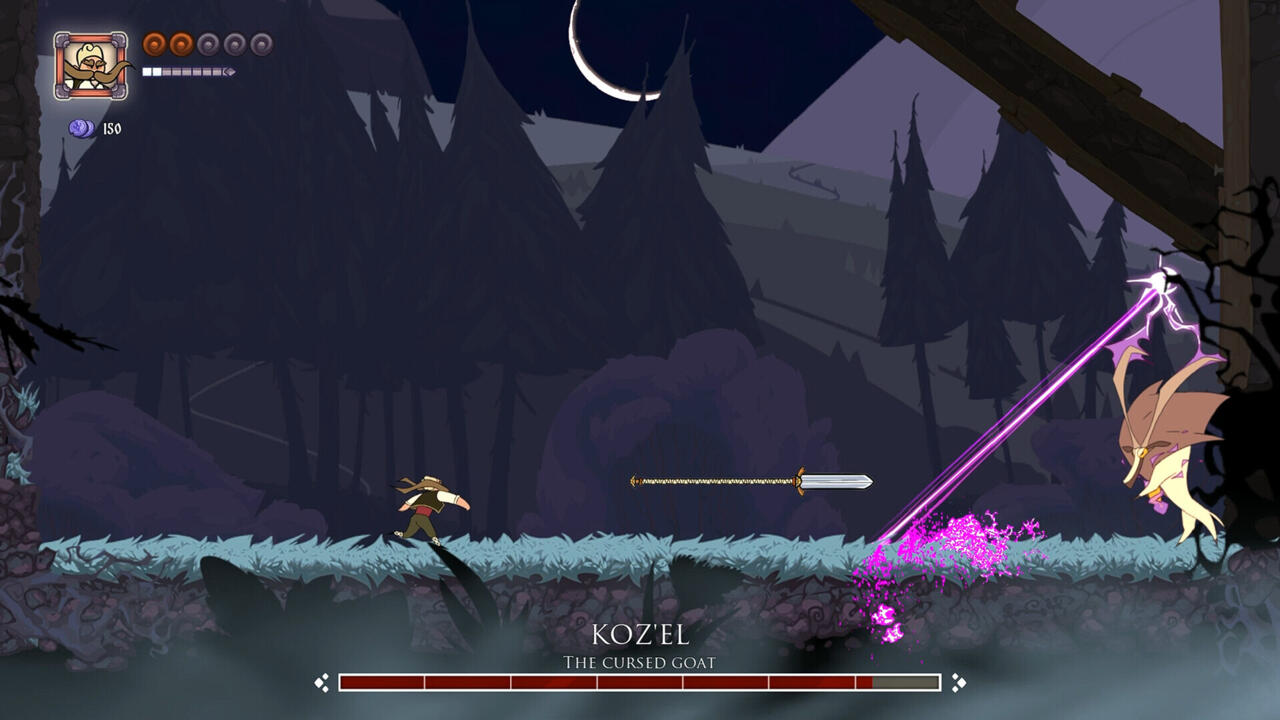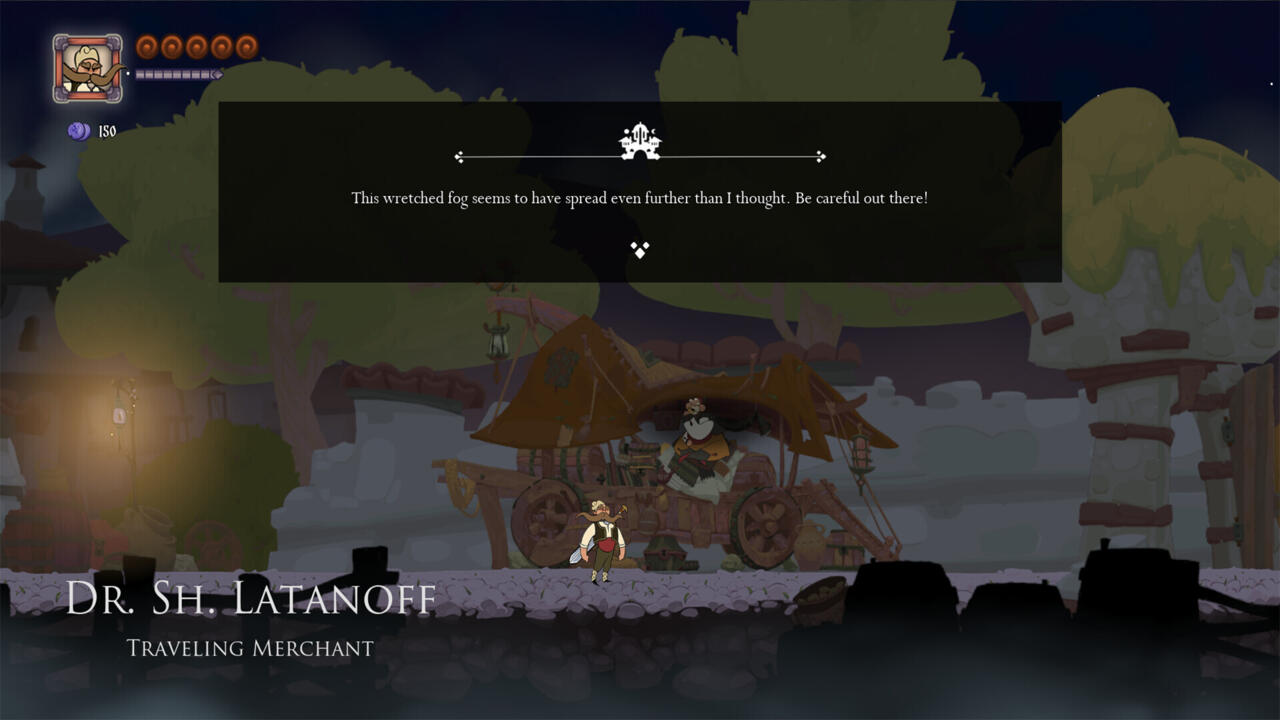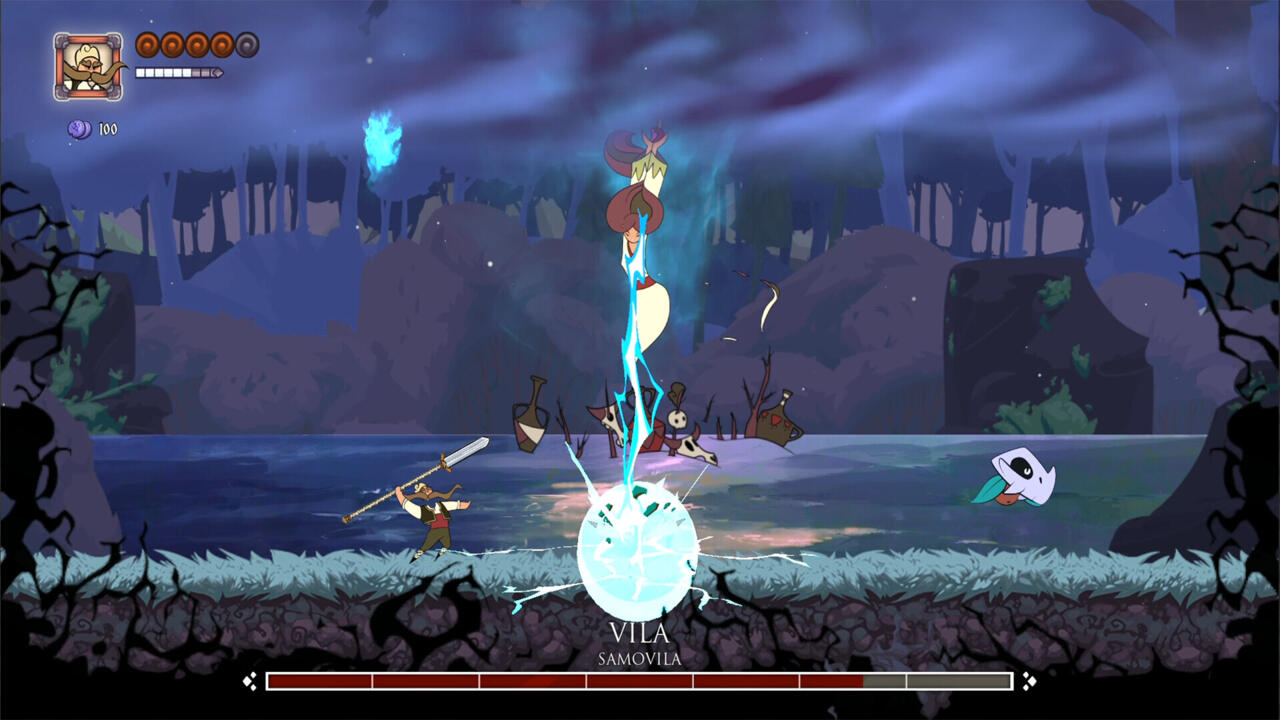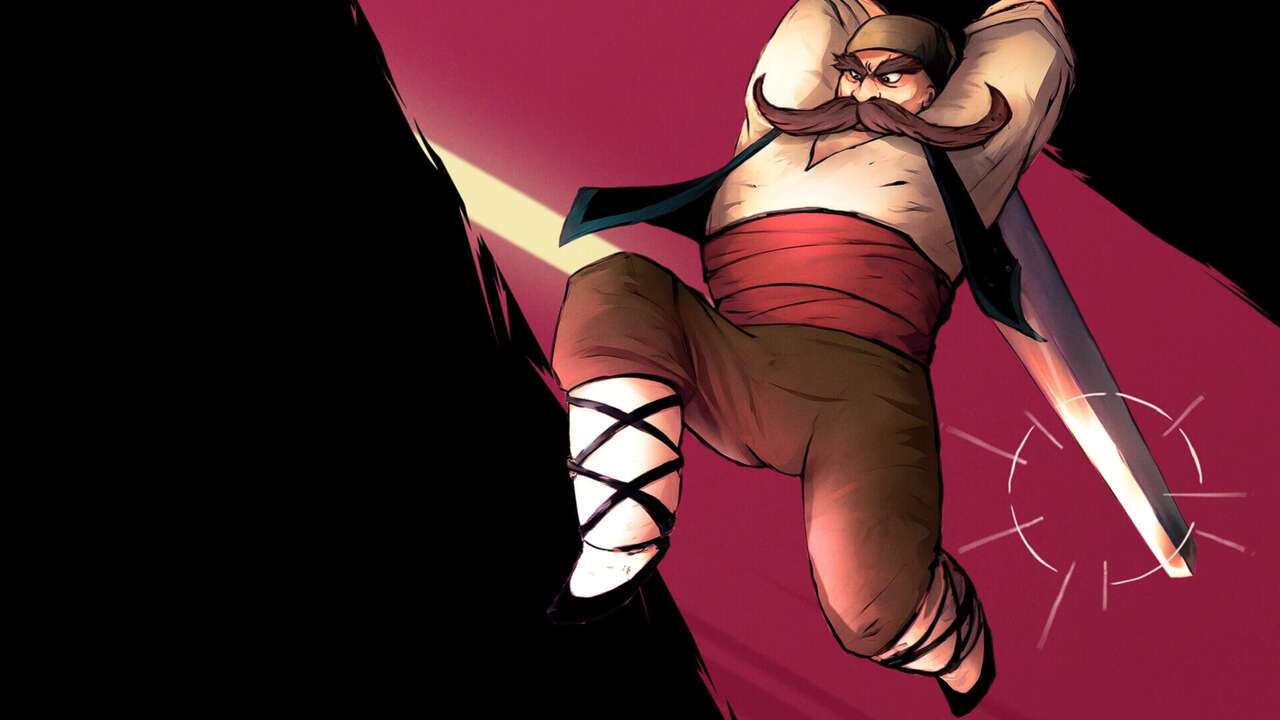Marko: Beyond Brave is not at all what I expected. From the hand-drawn visuals to the cryptic lore tablets, and from the silent protagonist to the largely underground opening levels, I figured it would tickle the same part of my brain that adores the likes of Hollow Knight. But Beyond Brave seems to put a far heavier emphasis on grounded combat–more than I’m used to when it comes to a metroidvania. In the hour demo I played, I never quite got used to it, but the Slavic folklore-inspired world seems interesting and I want to try the game some more if only to see more of it.
In Beyond Brave, you play as the titular Marko, a warrior who fits the strong-and-silent archetype for a metroidvania protagonist to a T. When his village is attacked by Entropy, he and his fellow warriors attempt to fight back and immediately fail. Left alone, Marko has to continue on his own, delving into twisting caverns that snake beneath his town, returning to the surface to buy new items or forging ahead through previously unreachable locales once he unlocks a new traversal ability.
“We love games as a storytelling medium,” Studio Mechka head Boyan Vasilev told me. “They are a great way of telling a story to someone across the globe in the universal language of play, and what better story to tell than the one you grew up with, right? We are borrowing themes from multiple Slavic fairy tales to create a unique universe with its own rules, characters, and lore. The main theme, however, is that of the underdog and his journey to becoming a hero. Marko starts as the youngest and weakest–at least at first–of his very-accomplished brothers, who are both already famous heroes, and so Marko has to prove himself along the way. The world, on the other hand, tells a more tragic story. The player will discover the hows and whys of Zagora: how it rose to glory and how it fell from grace and into ruin. It is the story of the people who inhabited it, akin to the rise and fall of the Roman Empire.”
I didn’t do a lot of backtracking and ability-unlocking in the first hour. Most of my time was spent fighting bosses and slowly cutting through horde-filled hallways. Getting around was tough–Marko isn’t acrobatic at all to start, seemingly lacking any advanced movement techniques to aid in early traversal. He can’t bounce off of the environment from the start like Hollow Knight’s Knight, for instance, nor can he wall-jump like Super Metroid’s Samus. I really struggled with the early platforming segments, frustratingly dying on what would be easy jumps in other games–falling into spiked pits I could not bounce out of or being unable to get enough distance on a jump unless I leaped at the exact moment. These were challenges I’d expect later in a metroidvania once I’d unlocked enough abilities to have a chance of recovering from a mistake, or find in a different genre of game altogether (like a platformer). Instead, I had to irritatingly die at the same point multiple times. Getting past enemies felt a lot harder too. I couldn’t easily maneuver past them or embrace my tried-and-true strategy of taking the high ground. I couldn’t bounce off a boss’ head like Hollow Knight’s Knight or shoot down at enemies who couldn’t reach me like Metroid’s Samus.

That isn’t to say Marko is helpless. Far from it. He’s slow but hits pretty hard. And interestingly, he starts the game with a backward dodge. It’s not very fast and you can’t use it in the air, but it’s valuable for getting out of trouble. I never quite got into a familiar pattern with it in the hour I played, but the few times I managed to pull off a successful backstep and then follow up with a forward lunge were incredibly satisfying.
“When designing the game and the core mechanics, we want to do something interesting that is more physical and combat-oriented,” Vasilev said. “Originally we had a forward roll; Marko could dodge under attacks or obstacles, and it created new traversal methods, which was interesting in itself, but nothing great. The backstep dodge, on the other hand, is something that is mostly combat-oriented. We are addressing a problem that we found in similar games where combat is often clunky and unnatural, mostly because if you want to back away from an enemy or danger, you have to turn around and run away. With the backstep, you can back away from something without actually turning your back, and you can then follow up with a strike on your own, all without changing direction. This makes combat flow a lot more naturally, as you are exchanging blows with your enemy instead of running, and of course, it looks pretty cool.”
In my time with the demo, I did unlock an aerial dash that made platforming so much easier. More upgrades like this await, and even though Marko primarily can only get around the world at the start by slicing his way through everything, he will be able to more easily jump past threats in later parts of the game.

“Having a sense of progression is very important for us because it ties directly with how accomplished the player feels when playing,” Vasilev said. “As Marko progresses through Zagora, he picks up a lot of movement upgrades, including acrobatic jumps, pogo–striking objects below you in order to stay in the air–teleportation, throwing multiple weapons, and more. The world, on the other hand, evolves with Marko, and as he gets further into the ruined kingdom, the decay becomes more and more apparent and the path requires more and more acrobatics to get across.”
Vasilev confirmed my suspicion that Beyond Brave becomes less linear over time. Though there are spaces to explore at the start, the opening hour of Beyond Brave feels railroad-y and too linear. I wasn’t a fan of feeling like I was being funneled in a specific direction at all times and look forward to seeing a world that opens up and affords me the chance to get lost and uncover surprises.
“I like to think of the game as a giant maze; you only realize how truly lost you are when you are almost at the center,” Vasilev said. “In that sense, the game opens up the more you play, and the more your abilities improve, the more options you’ll have. The correct path isn’t a singular road with a magnitude of branching dead ends, but instead is a multitude of choices that expand, loop around and open other possibilities that just happen to arrive at the same destination.”

The game will have unorthodox boss fights too. I found one in the demo: I stumbled into a field where a genie-like nymph emerged from a container and attempted to drown me with repeated bursts of pressurized water. The speed at which her blasts were flung at me increased over time, and it was impossible to actually attack (or if it was, I could not figure out how to do so). But as time went on, the boss’ health bar slowly depleted–it was a test of endurance and dodging ability, not combat prowess. It was a lot of fun, and I enjoyed it far more than the traditional boss fights–like a rampaging goat and tongue-whipping frog–that felt like encounters I’d seen in plenty of games before. They weren’t boring, but they felt overly familiar for the metroidvania genre in terms of how to beat them. And, surprisingly, the backstep mechanic never felt necessary to overcome them. Perhaps later boss battles lean into the mechanic more, but early on, it seems like only normal enemies are built around the backstep. Meanwhile, the endurance trial against the nymph was something I’d never faced in a metroidvania game before.
“The Samodiva–similar to a nymph–you encountered is essentially a guardian of nature,” Vasilev told me. “They are creatures that will act out in violence against anyone who threatens the natural order of their habitat, even if just trespassing. The Samodivas in Slavic folklore are not inherently malicious, and we tried to convey that through the fight mechanics. There are other interesting encounters in the game that use similar non-traditional gameplay and combat approaches. For instance, we have a boss that is entirely themed around sounds and sound waves. These encounters are essential to the story, too, conveying the complexity of the world and how not everything is black and white, not everyone you fight is a foe, and not every problem can be solved with the blade.”
Even if I only saw one example, those types of fights are what I’m most looking forward to in Marko: Beyond Brave. Perhaps if I get the hang of the timing of the backstep, I’ll come to love and appreciate the traditional combat encounters too. The few times I managed to pull it off, the game felt really good. But I’m also worried about how I’ll manage with a combat system that seems built around a manner of defense that isn’t a shield, forward dodge, or parry (because that’s what I’m used to, and I am a creature of habit). I’m more than willing to give the game a chance to change my mind, though.
Marko: Beyond Brave is set to launch for PC on September 17.
